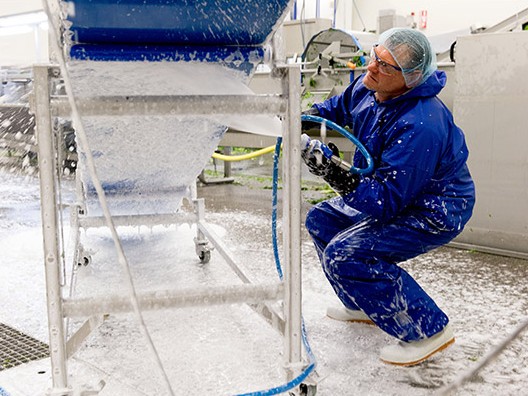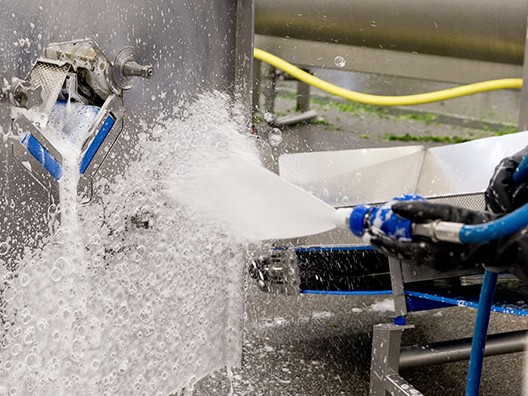
A food manufacturer’s production process is always carefully designed down to the smallest detail, yet that efficiency is sometimes still lacking in the cleaning process. Cleaning should run as smoothly as a pit stop. Quality is safeguarded through training and a good quality assurance system.
Good hygiene always starts with drawing up a solid cleaning plan. Gert Visscher, director of the company Eco2Clean, explains that virtually all food manufacturers have a good cleaning plan in place and record the results. “But the problem is that the data often stands alone – there is no link to a control system. It’s possible for some tasks to be performed poorly, or not at all. Companies without an effective control system run the risk of those tasks not being rescheduled, and eventually becoming forgotten.” Eco2Clean pre-empts this problem with its HIMS software program. The system connects all the relevant information together, i.e. the cleaning activities, the quality criteria, the results and the cost pattern. The cleaning process is monitored and the results are translated into follow-up actions. “Recently, food safety has been the topic of much discussion,” says Gert. “I expect governments and retailers to soon start demanding that food manufacturers are always active at audit level so that hygiene is safeguarded effectively.”
Marc Rosendahl, owner of Brilliant Group Hygienepartner, has also noticed that hygiene standards are rising. “This is a direct result of the recent recalls, which have caused food producers to take a closer look at their record-keeping, such as control lists and a management system to monitor hygiene.” Moreover, he sees that cleaning could be done a lot more efficiently within many companies in practice. “Virtually every aspect of the production process has been carefully considered: a machine doesn’t stand still for a minute longer than necessary. But that level of efficiency is often lacking in the cleaning process. For example, employees have to walk further than necessary to get a sweeping brush, or spend time removing dirt which could have been prevented instead.” In order to improve the efficiency of this process, Marc pays a lot of attention to the time factor in his training courses. “We have a software package which includes a task planner. Each task has a target time, which enables employees to know precisely how long they are allowed to spend on certain activities. We also analyse the cleaning process and provide an overview of where time is being wasted. And we ensure that all equipment and resources are readily available. A trolley can be handy, for instance. This turns the cleaning process into a kind of pit stop, where every second counts.”
“We identify where time is being wasted”
Adaptations to machinery or production lines also create more efficiency. “When designing a production line, the focus is on manufacturing products,” says Oskar Evers, district manager food services at CSU. “There are often lots of nooks and crannies which are hard for cleaners to reach. That’s why we would like to be more involved in the design of equipment or production lines.” René Bakker, account manager at Hago Food & Industry, agrees. “One example is a vibratory sieve which discharges water onto the floor. With a small adjustment, that water can be collected in a pipe and led directly to a drain instead. For adaptations of this kind, we work closely with the hygiene consortium EHEDG and follow the hygienic design guidelines. The ultimate aim is to make cleaning easier.” It also makes a difference if companies keep their production areas reasonably clean. “We supply lots of cleaning materials to the meat industry,” explains Rob Kamphuis, owner of Labaz Hygiëne Concepts. “Production employees can of course drop everything at 5 o’clock and immediately head home, but it takes a minimum of extra effort to rinse the equipment before doing so. In that case, the factory is already visually clean when the cleaning team sets to work.” And sometimes it can be a good solution to employ a small cleaning team during the day too. “As a contract cleaning company, we have to comply with the Working Hours Act, and we ask our customers to help us to do so,” adds René. “A small cleaning pool during the day not only removes some of the dirt in advance. The other advantage is that it enables us to adhere to the regulations regarding working hours.”
One pitfall within large food manufacturers is that a purchaser will often choose the cheapest contract cleaning company. At such a low price, the company cannot deliver the right quality, which in turn leads to problems for the food producer. René admits that the pressure on prices is high. “But that is changing. Food manufacturers are increasingly realising that cleaning in the food industry is a specialism which must be done by experts. So ‘cheap’ can prove to be expensive in the long run. That’s why, during negotiations, we not only have contact with the purchasing department but also involve the head of production and the QA department in the process. Cleaning takes time, and hence costs money, but if all the basic criteria are right then effective cleaning will also increase profitability – such as by reducing downtime, reducing rejects as a result of suboptimum cleaning and reducing the use of water and chemicals.” Another company which feels the pressure on prices is CSU. “But as a large company we can’t afford to compromise on quality,” states Oskar. “That would put us at risk of bad publicity and could potentially harm our business. In practice, we often have very long-term customer relationships. Companies choose us because we take a problem-solving approach and because they trust us. That’s more important than the lowest price.”\
Another important aspect of cleaning is training. Labaz provides training to employees every year. “Annual training is necessary because the key to effective training is repetition,” says Kamphuis. “Plus, there are always a number of staff changes over the course of a year.” He runs training courses in Dutch, German and English. Additionally, a Polish interpreter often attends the sessions and the course materials – such as the presentation and questionnaire – have been translated into Polish. “We’ve thought about offering the course in Polish too,” continues Kamphuis. “But next year we might have an influx of Romanians, which is why we’ve opted to use an interpreter instead.” In his courses, the emphasis is on safety. “We do a lot of business with the meat industry, which is working with ever-greater volumes and hence the equipment is getting increasingly dirty during the production process. We have to use high-quality detergents to soak off the proteins.” The training courses from Brilliant Group Hygienepartner focus heavily on applying knowledge in practice. “The training sessions mainly comprise practical instructions for work situations,” says Marc. “We walk around the company with employees. We keep the information simple, short and to the point, and we use lots of pictures. Moreover, training is a continuous process. We identify which aspects of the cleaning process could be done better. We then draw up improvement plans, which form the basis for the next training course.”
“It’s impossible to exclude all risks”
When it comes to cleaning, a key question is: how clean is clean? In Lennard Muilwijk’s experience, auditor from Bureau Veritas Certification, the production lines are often cleaned effectively. “The places where the cleaning falls short are the ceilings, the areas behind the machinery and the drains.” He adds that it can sometimes be revealing to visit a factory just after cleaning has been done, such as at the weekend. “As an outsider, you sometimes come across completely unacceptable situations, such as equipment covered in a layer of grease or product remnants that have been overlooked. That’s obviously the condition that the production team and cleaning team class as ‘clean’.” Gert (Eco2Clean) has also noticed that companies can develop a blind spot to cleaning over the years, which is why Eco2Clean regularly performs hygiene inspections within companies in the evenings or at the weekend. “At first glance, the factory might look clean. But our specialists see a clean factory through different eyes and will crawl through it on their hands and knees if necessary. This approach reveals numerous improvement points.” Kamphuis (Labaz) sometimes gets into discussions with customers about the desired level of hygiene. “For example, some customers don’t believe it is necessary to disinfect their factory because it looks clean and the bacterial counts are good. I consider that a risk. It’s better to include a safety margin, since that significantly reduces the chance of a product recall.”
On the other hand, a factory does not need to be a completely sterile environment. “If you take very detailed measurements, you will always find something,” says Gert (Eco2Clean). He regards it as a bad sign if readings always display counts of zero. “In such cases, I’d rather use a more precise measuring method. That might mean that you find ten colonies, but at least you can monitor trends then. The ten colonies might grow into 30 colonies, which would mean that the hygiene level is falling and action must be taken to tighten up on it.” Lennard adds that it is almost impossible to exclude all risks. “Above all, the hygiene plan must be aligned with the risks that the company faces. Even companies which take the utmost care with hygiene can be surprised by a recall, as the recent incidents demonstrate. Everything is clean and yet there is still a tiny nook or cranny where contamination forms. It’s always a place that no one has thought of before. Of course that’s hard to accept, but see it as a lesson for the next time.”
“The training sessions mainly comprise practical instructions for work situations”

The trend for the future is that the level of hygiene will rise even further, especially as a result of the tougher demands placed on manufacturers by the government and retailers. As Lennard sees it, a certain category of companies will have to make drastic changes in order to keep pace with that trend. “By that, I mean companies which started out small but have grown larger over the years. They are sometimes based in a jumble of adjacent buildings, resulting in illogical routing which doesn’t naturally proceed from raw to cooked, for instance. They will have to make significant adjustments in order to meet future standards.”
Source: Eco2Clean